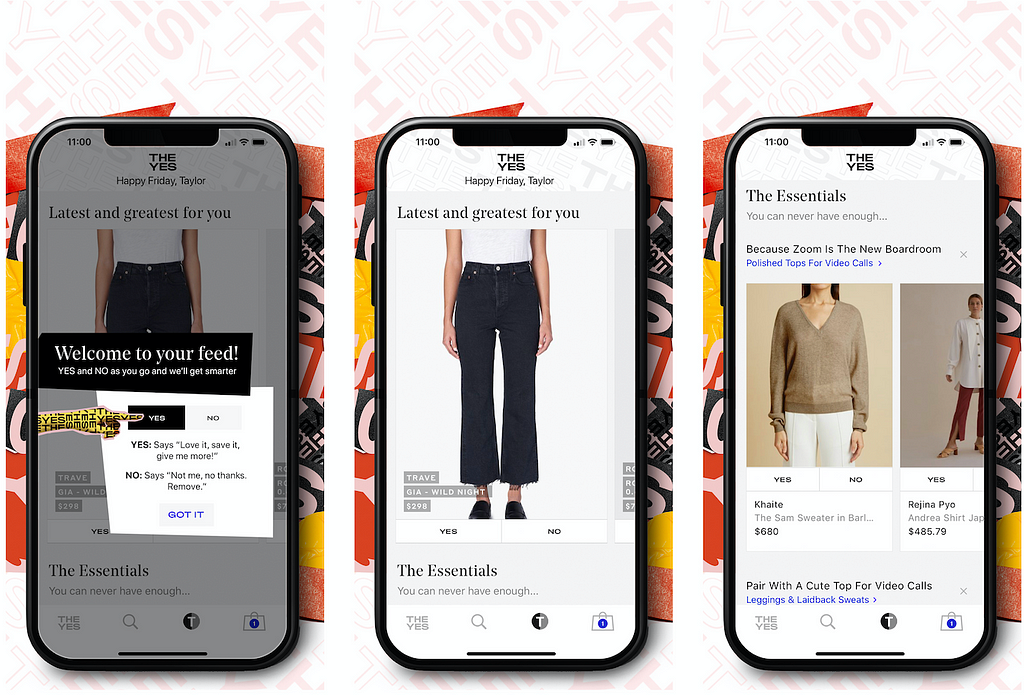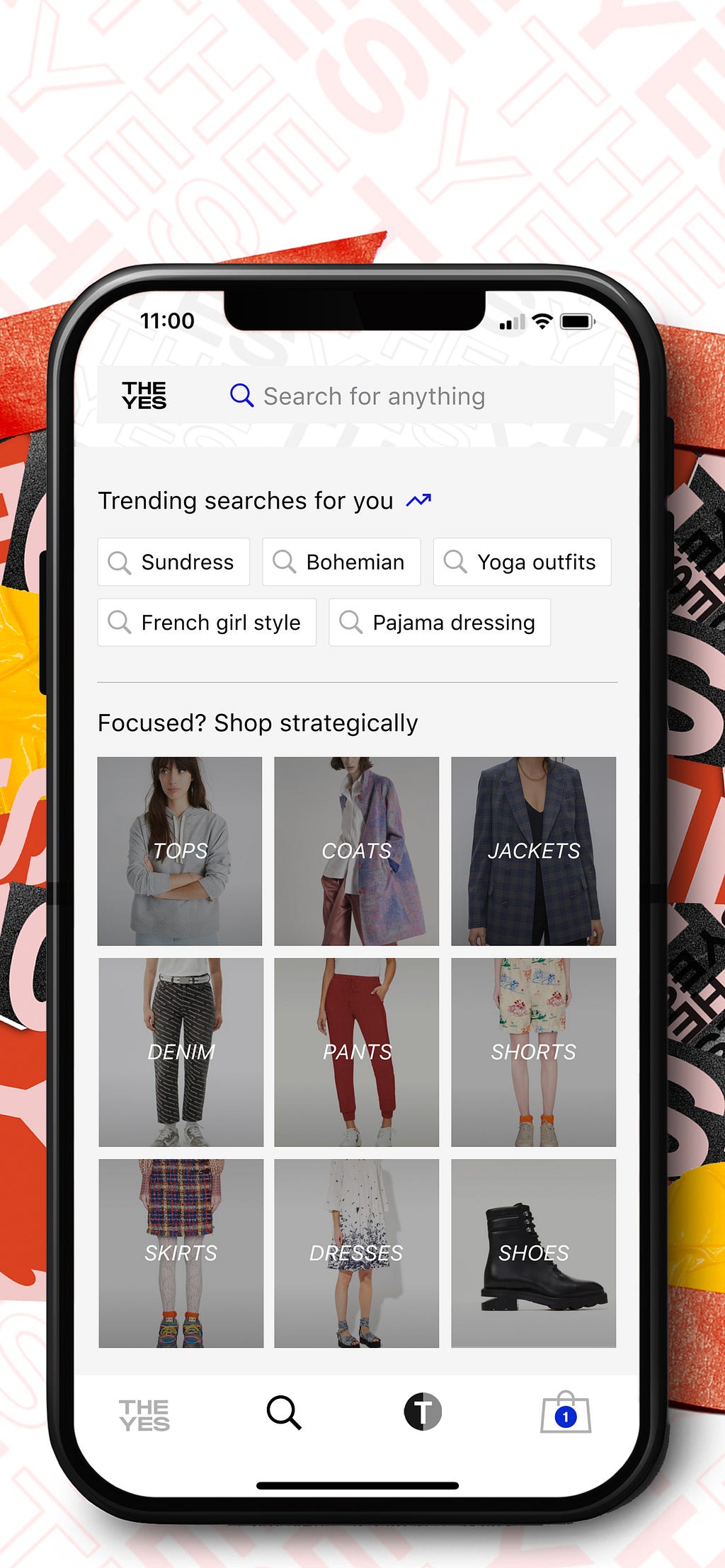
Bornstein launched the new women’s shopping platform THE YES, alongside co-founder and Google alum Amit Aggarwal in May of 2020, in the middle of a pandemic when just about everything, including shopping, was virtual. With a resume including Chief Operating Officer of Stitch Fix, Chief Digital Officer of Sephora, and credited for launching Nordstrom and Urban Outfitters e-commerce websites, we believed that if someone was going to transform e-commerce, it would be Bornstein.
THE YES platform was created to revolutionize the online shopping experience using machine learning to build algorithms giving shoppers a one-to-one feed. Based on a short Q&A, and the user’s “Yes” or “No” on styles, the technology learns a shopper’s fashion preferences and the platform gets smarter over time. Customers are matched with product relevant for them and brands are given a way to connect with new shoppers.
We sat down with Bornstein a few months post-launch to discuss how the company is navigating this pivotal moment in time and learn where she thinks retail is headed post-pandemic.
For the most part, women love the app — some are even obsessed. We’ve heard many things like “this has changed my life” and “I’m completely addicted to it.” Users love that there is an assortment of brands from high to low end. We’re seeing customers purchase items from brands like Everlane and Levi’s, alongside brands like Rosie Assoulin and Prada.
We still have a lot of work ahead of us, but we have some good early metrics. We have a high engagement rate; 80% of people who download the app built a ‘YES list’ with over 30 items in it. People love to “yes” and “no” items, and they’re coming back regularly to engage. We’re finding that people are checking their feeds daily, and about 40% of people who purchase an item, come back and buy again within the month. This is higher than the industry average.

Given my decades focused on fashion e-commerce, I suppose I’ve become an expert on this specific topic. I’m an avid online shopper, and I’ve been thinking about how to make the experience better for 20 years, but it wasn’t until the last few years that technology finally caught up with the possibilities.
We can now use AI to better understand the individual user. We’ve also found ways to reduce work for the brand. We’ve realized we can leverage the brand’s photography and e-commerce shots, but use design to make feeds still look coherent, so we don’t have to pay to reshoot all the products as most fashion websites do.
We’ve also found a way to capture product data without adding work for the brands. Instead of having to upload all their imagery and information, we built a software system that basically pulls in everything automatically and uses machine learning to understand every view of an image and decide which one to feature.
With store closures, many retailers canceled their orders and brands are sitting on the excess product. For the many brands that aren’t able to sell through their normal channels, THE YES offers a new means of distribution, that doesn’t require them to transfer their inventories. We use drop shipping, and by keeping their inventory in one place, we are also reducing the environmental impact of each additional shipment.
With some brands, we are even able to access the inventory that’s in their stores which may be closed due to COVID. We’re another way for these stores to get their product off store shelves.
Supply chains were definitely interrupted by the pandemic. Manufacturers in China resumed operations fairly quickly. Italy’s luxury brands are finding creative ways to catch up. But considering how different life is in the US right now, we are definitely not experiencing normal shopping habits. One of the most searched fashion items is now a face mask, and there is not a current need for new workwear. The fashion world is still pretty focused on comfort right now, but when the world opens up, I think we will see a shift. We will be sick of our sweats and loungewear. People will be excited to dress up and put on pretty clothes and shoes. Athleisure will always have its place, but I think there will be a rebirth of dressing up once we can finally get out of our houses.

While my favorite pastime is shopping in stores and I don’t believe physical retail will go away altogether, a shift is clearly underway. The experience of shopping is not keeping up with the times in many cases. Walking into a large department store feels impersonal and inefficient. There is an overwhelming amount of product yet it’s hard to find what you’re looking for, and if you do, chances are your size is not available. Some stores still offer helpful services, but others don’t even have that. Going to a retail store to fill a specific need, such as finding a dress to wear to a wedding, doesn’t work well when compared to the selection available online. Now that we have the web, it’s far more effective and efficient to meet your product need online.
This is why visits to stores driven by a customer’s “necessity to buy something” have gone way down. We were seeing this even before the pandemic, every year, traffic to physical stores was shrinking. As the younger generations grow up and become a larger part of the buying population, the more the shift will continue online.
COVID sped up store closures that were probably inevitable for many retailers. For too many companies, the e-commerce retail infrastructure was built around the physical stores being the profit engine. It should have been the opposite. Without having to account for real estate, inventory, and physical labor, companies should be more profitable and efficient online. The retail stores that survive will need to have incredible service, great product for its market (which may mean a more narrow segment) and a great experience. We are already seeing that stores for DTC brands serve as showrooms and a way for customers to get to know a brand. In this model, the store is more of a marketing expense for brands, and not the core profit driver.
We announced our $30 million Series A round back in October of 2019, which Comcast Ventures participated in alongside Forerunner, NEA and True Ventures. Since then, our biggest priority has been to make sure our app works really well for the core user by fine-tuning the algorithm to get the best-personalized recommendations for each individual. We’re planning on adding many more brands and many new features including one that lets you shop alongside friends and influencers. We‘re currently only an iOS app, so we plan to expand to more devices and formats, including Android and web. We’re also planning to expand geographically and add menswear.
I get questions all the time about adding beauty. Someday we may add other categories as well, but I believe our focus will drive our success. I’m not sure that Google, Pinterest, or Facebook will be as good as we will become at fashion recommendations because it requires a laser focus on this complex category. All of our algorithms are tailored solely to fashion, which is highly complex. If we were to add any new categories in the future, we would need to build an entirely new set of algorithms. From our experience, this takes years of training data models. So for now, THE YES will stay focused on the fashion category — which is a $300 billion market in the US alone.
This interview has been edited for clarity and brevity.
THE YES founder and e-commerce expert, Julie Bornstein, sheds lights on the future of retail was originally published in The Forecast on Medium, where people are continuing the conversation by highlighting and responding to this story.